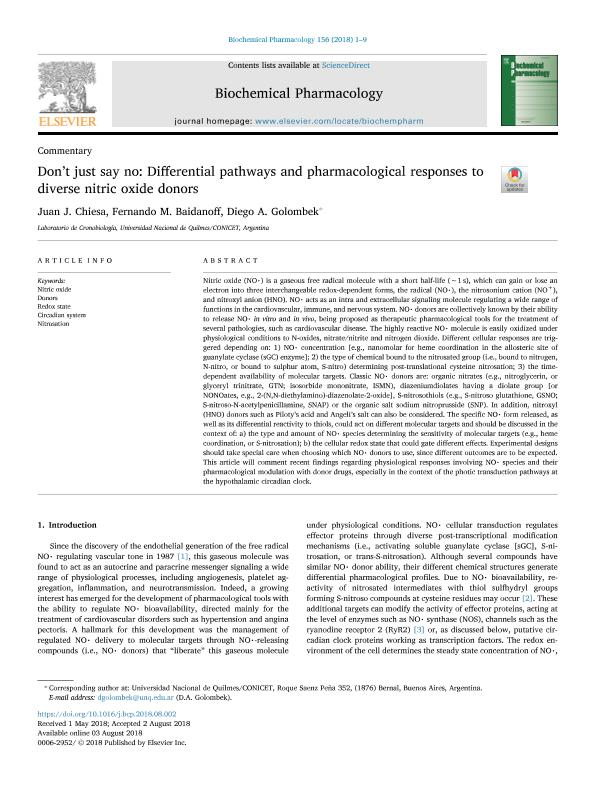Artículo
Don't just say no: Differential pathways and pharmacological responses to diverse nitric oxide donors
Fecha de publicación:
10/2018
Editorial:
Pergamon-Elsevier Science Ltd
Revista:
Biochemical Pharmacology
ISSN:
0006-2952
Idioma:
Inglés
Tipo de recurso:
Artículo publicado
Clasificación temática:
Resumen
Nitric oxide (NO[rad]) is a gaseous free radical molecule with a short half-life (∼1 s), which can gain or lose an electron into three interchangeable redox-dependent forms, the radical (NO[rad]), the nitrosonium cation (NO+), and nitroxyl anion (HNO). NO[rad] acts as an intra and extracellular signaling molecule regulating a wide range of functions in the cardiovascular, immune, and nervous system. NO[rad] donors are collectively known by their ability to release NO[rad] in vitro and in vivo, being proposed as therapeutic pharmacological tools for the treatment of several pathologies, such as cardiovascular disease. The highly reactive NO[rad] molecule is easily oxidized under physiological conditions to N-oxides, nitrate/nitrite and nitrogen dioxide. Different cellular responses are triggered depending on: 1) NO[rad] concentration [e.g., nanomolar for heme coordination in the allosteric site of guanylate cyclase (sGC) enzyme]; 2) the type of chemical bound to the nitrosated group (i.e., bound to nitrogen, N-nitro, or bound to sulphur atom, S-nitro) determining post-translational cysteine nitrosation; 3) the time-dependent availability of molecular targets. Classic NO[rad] donors are: organic nitrates (e.g., nitroglycerin, or glyceryl trinitrate, GTN; isosorbide mononitrate, ISMN), diazeniumdiolates having a diolate group [or NONOates, e.g., 2-(N,N-diethylamino)-diazenolate-2-oxide], S-nitrosothiols (e.g., S-nitroso glutathione, GSNO; S-nitroso-N-acetylpenicillamine, SNAP) or the organic salt sodium nitroprusside (SNP). In addition, nitroxyl (HNO) donors such as Piloty's acid and Angeli's salt can also be considered. The specific NO[rad] form released, as well as its differential reactivity to thiols, could act on different molecular targets and should be discussed in the context of: a) the type and amount of NO[rad] species determining the sensitivity of molecular targets (e.g., heme coordination, or S-nitrosation); b) the cellular redox state that could gate different effects. Experimental designs should take special care when choosing which NO[rad] donors to use, since different outcomes are to be expected. This article will comment recent findings regarding physiological responses involving NO[rad] species and their pharmacological modulation with donor drugs, especially in the context of the photic transduction pathways at the hypothalamic circadian clock.
Palabras clave:
CIRCADIAN SYSTEM
,
DONORS
,
NITRIC OXIDE
,
NITROSATION
,
REDOX STATE
Archivos asociados
Licencia
Identificadores
Colecciones
Articulos(SEDE CENTRAL)
Articulos de SEDE CENTRAL
Articulos de SEDE CENTRAL
Citación
Chiesa, Juan José; Baidanoff, Fernando Martín; Golombek, Diego Andrés; Don't just say no: Differential pathways and pharmacological responses to diverse nitric oxide donors; Pergamon-Elsevier Science Ltd; Biochemical Pharmacology; 156; 10-2018; 1-9
Compartir
Altmétricas




